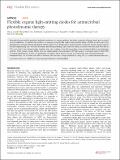Flexible organic light-emitting diodes for antimicrobial photodynamic therapy
Abstract
Bacterial infection is a serious and growing problem as antibiotic resistance grows leading to patient suffering, death and increased costs of healthcare. To address this problem, we propose using flexible organic light-emitting diodes (OLEDs) as light sources for photodynamic therapy (PDT) to kill bacteria. PDT involves the use of light and a photosensitizer to generate reactive oxygen species that kill neighbouring cells. We have developed flexible top-emitting flexible OLEDs with the ability to tune the emission peak from 669-737 nm to match the photosensitizer, together with high irradiance, low driving voltage, long operational lifetime and adequate shelflife. These features enable OLEDs to be the ideal candidate for ambulatory PDT light sources. A detailed study of OLED-PDT for killing S. aureus was performed. The results show that our OLEDs in combination with the photosensitizer methylene blue can kill more than 99% of bacteria, which indicates a huge potential for using OLEDs to treat bacterial infections.
Citation
Lian , C , Piksa , M , Yoshida , K , Persheyev , S , Pawlik , K , Matczyszyn , K & Samuel , I D W 2019 , ' Flexible organic light-emitting diodes for antimicrobial photodynamic therapy ' , npj Flexible Electronics , vol. 3 , 18 . https://doi.org/10.1038/s41528-019-0058-0
Publication
npj Flexible Electronics
Status
Peer reviewed
ISSN
2397-4621Type
Journal article
Description
The authors are grateful to the European Research Council (grant 321305) and EPSRC (grant EP/L015110/1) for financial support. The authors would like to acknowledge EU grant Polythea (grant 764837) as well as support from the Polish Ministry of Science and Higher Education for the Faculty of Chemistry of WUT.Collections
Items in the St Andrews Research Repository are protected by copyright, with all rights reserved, unless otherwise indicated.

